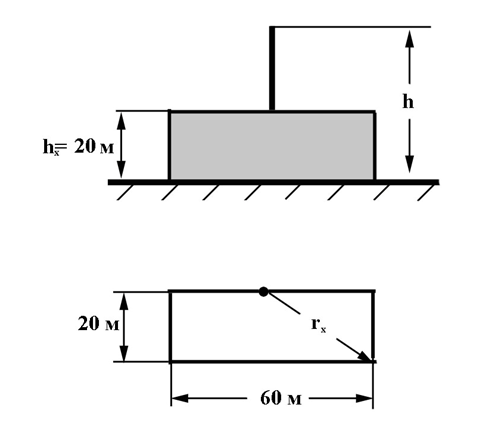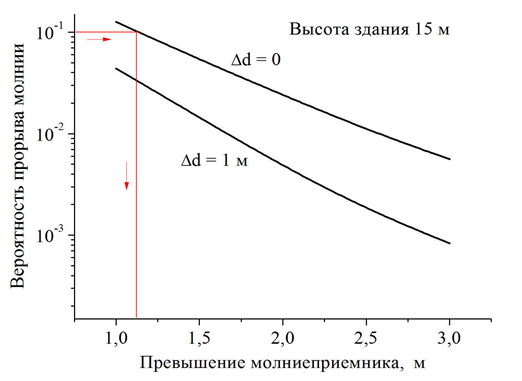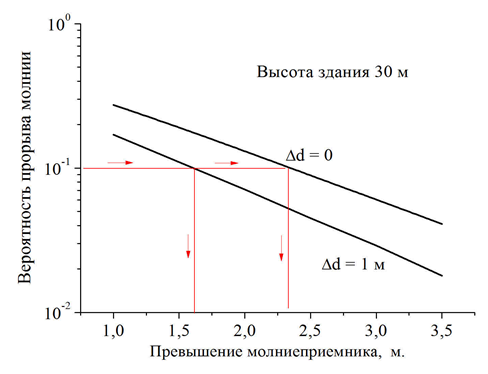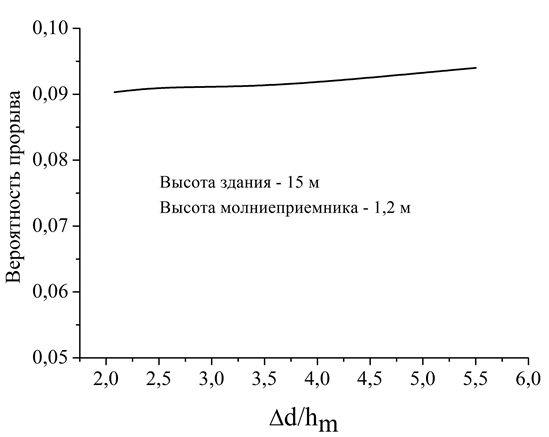From the series of articles "Lightning protection of residential and public buildings - answers to frequently asked questions in the design".
It seems that the designers like single lightning rods, especially rod ones. The conical surface bounding the protection zone is easily made by elementary formulas. If the object is entirely located within the scope of this cone, protection against direct lightning strikes with the required reliability is guaranteed. There is nothing to worry about.
I'll try to show on a certain example, that the situation is not so simple and obvious. Let the protected rectangular building with a height hx M = 20m have sizes of 60 x 20 m. It is supposed to put a single protective lightning rod as shown in Fig. 1. Lightning rod must ensure reliable protection 0.9.

Figure 1
According to empirical formulas of table 3.4 of the standard IS-153-34.21.122-2003 the height of the protected area cone at the height of the lightning rod h is equal to
 (1)
(1)
and protection radius at the ground level of 30
 (2)
(2)
The radius of protection for a height hx is equal to
 (3)
(3)
where
 (4)
(4)
For the selected position of the lightning rod the protection radius at the height hx = 20 m should be  that gives h ≈ 54 m for the height of the lightning rod. The number of lightning strikes into such a lightning rod in defined by the contraction area SM = 9πh2 ≈ 0,082km2. This is almost 4 times larger than the area of lightning contraction by the protected building without a lightning rod. Therefore, installation of a lightning rod will increase the number of very close lightning strikes almost 4 times. The specialists in internal lightning protection will be hardly satisfied by this, because, taking the lightning channel upon itself, the lightning rod will virtually have no effect on the electromagnetic field of its current and, consequently, on the level of induced surges in internal circuits of the building.
that gives h ≈ 54 m for the height of the lightning rod. The number of lightning strikes into such a lightning rod in defined by the contraction area SM = 9πh2 ≈ 0,082km2. This is almost 4 times larger than the area of lightning contraction by the protected building without a lightning rod. Therefore, installation of a lightning rod will increase the number of very close lightning strikes almost 4 times. The specialists in internal lightning protection will be hardly satisfied by this, because, taking the lightning channel upon itself, the lightning rod will virtually have no effect on the electromagnetic field of its current and, consequently, on the level of induced surges in internal circuits of the building.
So, in all possible situations, lightning rods shall be designed so, in order to avoid a significant increase in the number of lightning strikes, compared to the number of strikes into an unprotected object. For this reason, a system of many lightning rods of small elevation over the protected object is preferable than a single lightning rod of high altitude.
This conclusion cannot be called a discovery in lightning protection. The system of a large number of lightning rods of small elevation has been firmly fixed in European practice. National standards for lightning protection also do not deny multiple lightning rods. There are two obstacles to their widespread introduction - a habit of designers to generally use single lightning rods and complexity of selecting the height of multiple lightning rods. The problem is that the basic structure of the protection zones is only possible for single and double lightning rods, both of the same type. For the designer, accustomed to rely on standard protection zones, the calculation of an even elementary combination of rod and catenary wire lightning rods becomes an impossible task. Appeal to the latest normative IS-153-34.21.122-2003 is essentially useless. Section 3.3.1 of this document says, "In a general case, the choice of lightning rods is held with the help of suitable computer programs ....." It is further stated that these programs should ensure calculation of any system of catenary wire and rod lightning rods for an arbitrary set of protected objects. The Technical Circular № 25/2009 of the Association "Roselectromontazh" states that the the software of "ENIN" JSC developed on the basis of statistical procedures for the selection of impact point of the lightning discharge fits the essential requirements. Such a program does exist and has been successfully used by specialists of the Institute. However, its commercial version is still not present on the domestic market. Today, this work is carried out with the help of "IMAG" company. There is a hope to see the result of it on the Internet in the nearest future.
Well, what can be done today? The answer to this legitimate question can still be extracted from the standard IS-153-34.21.122-2003. In section 3.3.2.5 you will see protection zone cof losed catenary wire lightning rods. In fact they are also multiple lightning rods. Four wires cover the protected object on the outer perimeter. In the perfect execution, the wires are pulled on the console mount to the external side of the protected building roof, creating the so-called negative protection angle (in the particular case, this angle may be equal to zero - the wires are hung right on the edge of the roof).
It is necessary to better understand the idea of closed ground wires. It has already been said about the radius of lightning contraction. They are sent to the object from the distance less or equal to three times of its height. For any high buildings, the total area of contraction significantly exceeds the area of the protected object. For example,for the previously mentioned 5-storey building 50 x 12 m , thedifference is more than twenty times. This means that the vast majority of lightning strikes into the object will be from the side, and therefore, the closed cable placed on the outer perimeter will be on their way with a great probability. This fact allows us to achieve reliable protection of buildings at a relatively low Lightning rod. Of course, with a large width of the object low lightning rods, placed over its perimeter, can fold in relation to the vertical lightning rods, aimed to the middle of the roof, but that is not of great importance, because the number of such "vertically oriented" lightning is relatively small and their breakthroughs to the protected object won't prevent from achieving reliable protection at the level of 0.9, which, as has been shown, is sufficient for residential and office buildings in a typical urban planning.
Calculated values of breakthrough probability in Fig. 2 and 3 make it possible to assess the effectiveness of closed wire lightning rods for buildings with 15 and 30 m, with the dimensions of 60 x 20 m. The cables were located either on the edge of the roof, or shifted to the outside at the distance ∆d = 1 m. The required excess of cables over the roof appeared to be very quite modest. At the reliability of protection 0,9 (III level of protection according to the classification of IS-153-34.21.122-2003) a wire can rise above the protected building with the height of 15 m of not more than 1.2 m (Fig. 2). For a 30-meter building, the required elevation will be approximately twice larger (Fig. 3).

Figure 2
Вероятность прорыва молнии – probability of lightning breakthrough
Высота здания 15 м – building height 15 m
Превышение молниеприемника, м – lightning rod elevation, m

Figure 3
Вероятность прорыва молнии – probability of lightning breakthrough
Высота здания 15 м – building height 30 m
Превышение молниеприемника, м – lightning rod elevation, m
Analyzing everything said above, it is clear that the wire can be replaced by a palisade of rod lightning rods of the same height. It is only necessary to assess at what distance to put them along the perimeter of the building. We can get a qualitative hint in the norm IS-153-34.21.122-2003. Section 3.3.2.3 gives protection zones of a double rod lightning rod. The zone with the reliability of 0.9 doesn't have a hit between the lightning rods, if the distance between them does not exceed their height of more than 2.5 times. There is reason to believe that, without such a hit a couple of lightning rods, in relation to its protective action, will assimilate as the wire section, that has no sag on the length of the site. To check the hypothesis, a series of numerical experiments with the help of the already mentioned calculation program by ENIN (tiime to note that with the help of this program, all protection zones in the national regulations on lightning protection were determined).
A building with plan dimensions of 60 x 20m of 15 and 30 m in height was selected for the estimation; the height of rod lightning rods installed on the roof, is taken to be hm = 1.2 and 2.5 meters. In fig. 4 you see the probability dependence of lightning breakthrough to the roof of the building at a height of 15 m from the location of lightning rods Δd. You can make sure that at Δd / hm <4 the probability of lightning breakthrough almost doesn't increase. A similar result is obtained for a building of 30 m with lightning rods hm = 2.5 m. Thus, for residential and office buildings of typical sizes the distances between lightning rods can be selected within Δd ≈ 4hm while ensuring the protection against direct lightning strikes at the level of 0.9.

Figure 4
Вероятность прорыва – probability of breakthrough
Высота здания 15 м – building height 15 m
высота молниеприемника, м – lightning rod height, m
Now, perhaps the most important thing. The justification of the decisions made must be proved to technical supervisors. It is not easy, because you cannot present a specific section on the lightning protection standard, directly confirming the legitimacy of the project to the person checking. Prior to the introduction of certified computational programs, it is possible to use the following methodology of justification of the chosen solution. AD 34.21.122-87 permits the use of meshes for the protection of buildings of II and III categories. Residential and office buildings refer to the latter, which recommends mesh with the cell size of 12 x 12 m. Introduce such a mesh in addition to the rod lightning rods into the project. It is not expensive. You already know that the protective effect of the mesh is close to zero. However it will fully satisfies the technical control bodies, and nobody can prohibit to add rod lightning rods to the mesh. The explanation can be very simple here - the desire of the customer. Please do not assume that the mesh is only necessary for decoration. Each rod lightning arrester must be connected with the ground with at least two down conductors. Place all lightning rods close to the mesh conductors and connect them with metal - the demand will be executed automatically, because the mesh is attached to the ground either through the metalwork of the building, or through specially provided down conductors.
It is left to discuss the installation technology of lightning rods on the roof. Their height is unlikely to exceed 3 m, but the number on the extended building could reach tens. Assembling by welding will hardly seem convenient and cheap. I advise you to take the advantage of paragraph 3.4 of the standard AD 34.21.122-87: "The connections of lightning rods with down conductors and down conductors wih ground electrode systems must be carried out, usually by welding, at the inadmissibility of fire works it is permitted to execute of bolted connections with transition resistance of not more than 0.05 Ohm with a mandatory annual inspection of the latter before each storm season. "Consider that the ban was imposed by the customer. You will still have to use bolt clamps that are widely present on the domestic market of lightning protection equipment. Leading European companies guarantee transition resistance in the clamp of up to 0,001 ohms even when exposed to aggressive environments.
E. M. Bazelyan, DEA, professor
Energy Institute named after G.M. Krzyzanowski, Moscow
Useful materials:
- Series of articles about lightning protection for beginners
- Series of webinars about grounding and lightning protection with Professor E. M. Bazelyan
- Elements of external lightning protection
- Consultations on the selection, design and installation of grounding and lightning protection systems
Related Articles:



